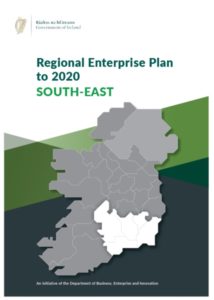The South-East Regional Enterprise Plan builds on the success of the South-East Regional Action Plan for Jobs (2015–2017) to ensure that it remains effective and that it continues to deliver jobs across the South-East region and can be robust to address the challenges we face, including Brexit.
The Minister for Business, Enterprise and Innovation Heather Humphreys, TD, was in Waterford on Friday 22nd March to launch a new Regional Enterprise Plan for the South-East to support enterprise growth and job creation through collaborative initiatives. The Minister was joined at the launch by Minister for Training, Skills, Innovation, Research and Development, John Halligan, TD and Minister of State at the Department of Housing, Planning and Local Government with special responsibility for Local Government and Electoral Reform, John Paul Phelan, TD.
The launch took place at the South-Eastern Applied Materials (SEAM) Research Centre at Waterford Institute of Technology (WIT), which is celebrating ten years of services to industry.
The development of the South-East Plan, incorporating counties Carlow, Kilkenny, Tipperary, Waterford and Wexford, was overseen by the Department of Business, Enterprise and Innovation, working with stakeholders from the South-East region, through a regional stakeholder Committee chaired by Frank O’Regan.
The South-East Plan identifies five Strategic Objectives, with actions to: enhance the existing environment for enterprise activity and growth, while building greater resilience; establish the South-East as a place of choice for talent and investment; develop a regional engagement strategy to highlight critical infrastructure developments; make the South-East a ‘learning’ region; and the develop the region’s tourism offering. The South-East Plan is the final one of nine Regional Enterprise Plans launched by Minister Humphreys in recent weeks.
The South-East Regional Enterprise Plan which encompasses counties Carlow, Kilkenny, Wexford, Waterford and Tipperary, contains the following Strategic Objectives and specific actions have been set out under each area:
Strategic Objective 1: Enhance the existing environment for enterprise activity and company growth; and build greater resilience in the South-East economy
Strategic Objective 2: Establish the South-East as a place of choice for talent and investment and market the region as such
Strategic Objective 3: Develop a regional engagement strategy that aligns with the Regional Assembly’s Regional Spatial and Economic Strategy and highlights the critical infrastructural developments required to enhance the economic potential in the South East
Strategic Objective 4: Make the South-East a ‘learning region’ with education, knowledge generation and exchange, and innovation as central activities that allow all to play a role in the economic, social and cultural development of the region
Strategic Objective 5: Develop the South-East as a region that is attractive to both domestic and international visitors with a sense of place and connected tourist amenities



